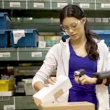
George is a freelance technology journalist. He has covered the telecoms market since 1999 and contributes to Global Telecoms Business, The Mobile Network, VanillaPlus and Wireless magazines in addition to producing content on behalf of operators, vendors and creative agencies.

Blogs by: George Malim
From smart thermostats to fitness trackers the race is on for companies to put out the next big connected product. However, during this foundation stage it’s essential that the companies developing or selling IoT technologies don’t take shortcuts when it comes to security protocol and ensure that the products they are selling do not pose any risk to the user’s security, writes Thomas Fischer, the principal threat researcher at Digital Guardian. (more…)

As is the case with so many industries in the current climate, digital is taking over. The demand for real-time information, sourced quickly, easily and where necessary reported in a way that allows for instantaneous analysis is changing the world, and not just in business but also sport. (more…)

Blogs by: George Malim
The Internet of Things (IoT) could have profound implications on our everyday lives – including our everyday safety – but there needs to be much greater collaboration between vendors, partners and customers to make it a reality, writes Dermot O’Connell, the executive director and general manager for OEM Solutions at Dell EMEA. (more…)

Blogs by: George Malim
If you think about it, hackers are canny, writes Adrian Crawley, the regional director for Northern EMEA at Radware, in the second part of his blog. (more…)

Blogs by: George Malim
Hacker is a dirty word. It conjures up images of someone locked in a dark basement coding into the night and unleashing digital horrors on the unsuspecting, writes Adrian Crawley, the regional director for Northern EMEA at Radware. (more…)

Blogs by: George Malim
As the Internet of Things becomes a reality and revolutions such as smart cities, digital manufacturing and connected vehicles are proliferating, the number of data points that could potentially be attacked by hackers are also rising at a staggering pace, writes Pavan Singh, the vice president and business head of the Covata Data Security Platform at Covata. Indeed, Gartner predicts that by 2020 there will be 9.7 billion connected devices, all of which represent a possible entry point for an attacker. (more…)

Blogs by: George Malim
A key requirement when selecting an LTE gateway that supports multiple Wide Area Network (WAN) links is the performance and the policies that define the switching behavior between WAN links. If you’re spending the extra money to buy a multi-network mobile gateway, you want to make sure that you’re actually going to get the performance you presumably want for your money, writes Bryan O’Flaherty Wills, the director of product management at Sierra Wireless. (more…)

Blogs by: George Malim
Homes, hospitals, shopping centres and department stores, airports, large manufacturing plants – all have a growing volume and variety of connected devices that rely on Wi-Fi to communicate and function, writes Areg Alimian, the senior director of solutions marketing at Ixia. (more…)

Blogs by: George Malim
The wow factor has played a major role in the public’s perception of the Internet of Things or IoT, writes Jonathan Duffy, the EMEA managing director of Netclearance. There’s something about the idea of a world made up of objects all linked together that resonates with people, so it is understandable that there is currently a lot of hype surrounding it. (more…)

Blogs by: George Malim
In the past, warehouse workers, otherwise known as pickers, would worth with lists and manually run a warehouse. This took pickers a long time to get shipments in order just and this laborious practice soon became outdated when digital advanced, writes Suzanne Vallance, who works for Ferrari Packaging, a wholesale packaging supplies company based in Scotland.
IoE practices in warehouses
Warehouses have started to use the Internet of Everything (IoE), robotic systems which makes the working day much more effective. IoE and voice picking have improved the efficiency of warehouse practices. Sensors can now even detect everything through a robotic system and businesses can check where their pallets are, whether that is in the warehouse or en route to the shipping dock.
Progressively, businesses are adapting to IoE technology and are connecting the different departments in their organisation. These warehouses, like new technology that we use every day, are called “smart warehouses” and have increased productivity across the board.
IoT and cloud software for business
Cloud software is continuing to develop and change security perceptions. Steve Banker from Forbes Online has stated that there are benefits of using IoT in warehouses and has highlighted how pickers are management are adjusting to the change: “Most well run warehouses have a Warehouse Management Systems (WMS) that depends upon bar code data. Warehouse floor level operations personnel and warehouse managers execute their tasks based upon this data.”
This is true, figures from 2015 have shown the growth of IoT in business, especially in the use of cloud technology:
Cloud software is hosted elsewhere, virtually and businesses manage their accounts by accessing the software over the internet. Organisations will be charged a cloud fee, however, this includes hosting services.
What is a voice picking cloud?
The main method of internet picking is through a voice picking cloud solution. This means organisations can host their information remotely.
This is beneficial as it means your business does not have to obtain, install or maintain servers. This will not only improve staff efficiency in the long run but it will cut costs. In-house IT hardware can be problematic when it comes to continual security and maintenance.
Argos is just one of the UK’s multichannel retailers that have moved away from paper trail picking. This has been beneficial to the company as they claim it has boosted staff productivity and accuracy.
Getting it right the first time is now more important than ever as the fast delivery pressure from the “Amazon effect” is hitting the retail business. Thankfully for Argos, its level of accuracy is going up and accuracy error rates have decreased from just over 1% to less than 0.3%.
By adopting a voice picking system a business will become more consistent. The paper trail has become outdated, therefore it may be worth businesses looking into business improvement across the board, especially in the operational side of businesses.
Operational vs technical in the warehouse
Remember, improving the technological side of your business is vital, but maintaining the operations section of it, is just as important.
Adopting cloud technology will allow for reduced operational costs, but it’s good practice not to reply on the cloud alone to protect your goods. Amazon uses the cloud to help protect against theft, by using a system that updates every thirty minutes, however for the SME traditional methods for protecting your stored items should not be disregarded. Invest in suitable packaging supplies that will act as a secondary dimension of protection for your goods.
IoT warehouse operations
Changing your business ethic can be risky, therefore it always worth trialling different methods of IoT. By using the internet to enhance your workplace it will not only encourage your employees to work harder but they will learn new, digital skills. The beauty of the internet is that is growing and it is never too late to change, you could see the benefits of IoT in your warehouse works in a matter of months.